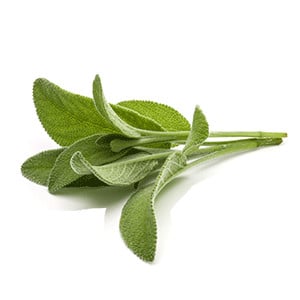Sage

Sage
Salvia
Plant family
Mint family (Lamiaceae)
Season Overview
Propagating
Planting
Harvest
Harvest
J
F
M
A
M
J
J
A
S
O
N
D
1ST YEAR
FOLLOWING YEARS
Details
Light requirement
Sunny
Water requirement
Dry
Soil
Light (sandy)
Nutrient requirement
Low
Light germinator
Germination temperature
18 - 22 °C (Degrees Celsius)
Plant distance
40 cm
Row spacing
40 cm
Seeding depth
0.5 cm
Instructions
The season for this plant has not yet begun. The following instructions are for the beginning season.
Mid of March
Propagating
Beginning of April
Transplanting
Mid of April
Harden
Description
Sage is a small, expansive shrub from the labiates family. The conditionally hardy plant forms deep roots and prefers a very sunny location with well-drained, rather dry soil.
Origin:
Mediterranean region
Growing tips
If you cut back sage a little in the spring, you ensure a vital new sprout. The aroma of the leaves is strongest just before flowering, so this is the best time for larger harvests, e.g. for drying. Individual leaves are harvested. Down-bent branches form roots when they come in contact with the ground. The rooted shoots can be cut off and planted. This is an easy way to propagate the sage.
Companion Plants
Abessinischer Kohl / Äthiopischer Senf
Aubergine / Eggplant
Broccoli
Broccoli raab / Stem cabbage / Cima di rapa
Brussels sprouts
Cabbage (Cabbage)
Cabbage (Pointed cabbage)
Cabbage (red cabbage)
Cabbage (Savoy cabbage)
Carrots
Cauliflower
Collard greens
Collard greens (Kale)
Collard greens (Tuscan kale / Dinosaur kale / Palm tree kale)
Common marigold
Gemüsekohl - Flower Sprouts / Kohlröschen
Gemüsekohl - Futterkohl
Gemüsekohl - Kai-Lan / Chinesischer Brokkoli
Gemüsekohl - Rippenkohl / Portugiesischer Kohl
Gemüsekohl - Wildkohl / Urkohl
Gliedkräuter
Kohlrabi / German turnip / Turnip cabbage
Lavender
Melon (Sugar melon)
Melon (Watermelon)
Mizuna / Japanese mustard greens
Napa cabbage / Chinese cabbage
Oregano
Pak Choi
Rapini / Broccoli rabe
Raps
Raps - Scheerkohl / Sibirischer Kohl
Rosemary
Rübsen - Choy Sum / Chinesischer Blütenkohl
Rübsen - Mizuna
Rübsen - Ölrübsen
Rübsen - Tatsoi
Rübsen - Wilde Rübsen
Rutabaga / Swedish turnip
Savory
Strawberry
Thyme
Tomato (Bush tomato)
Tomato (Cocktail bush tomato)
Tomato (Cocktail Stake Tomato)
Tomato (Stake tomato)
Turnip
Antagonistic Plants
Basil
Bean ((Scarlet) runner bean)
Bean (Broad bean / Faba bean / Field bean)
Bean (Hyacinth bean / Lablab-bean)
Bean (Lima Bean)
Chives
Courgette / Zucchini
Cucumber (Caigua)
Cucumber / Gherkin
Dill
Garlic
Garlic chives
Gartenkürbis - Patisson / Ufo-Kürbis
Gooseberry
Jerusalem artichoke / Topinambur
Kaplilien / Kaplauche
Leeks
Lettuce (Lettuce)
Lovage
Mint
Onion
Onion (Spring onion)
Ornamental pumpkin
Parsley
Pumpkin / Squash
Root parsley
Soybean
Wild garlic
Diseases
Root Rot
Downy mildew
Powdery mildews
Pests
Aphids
Cicadas